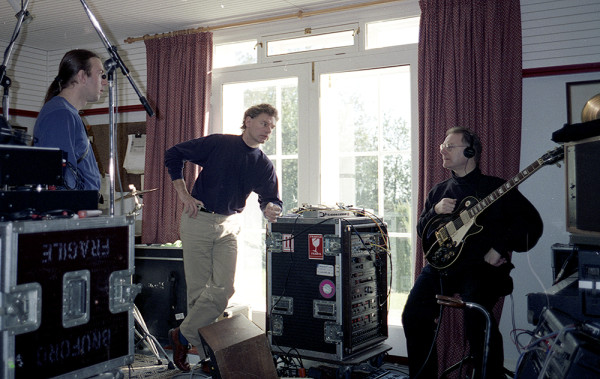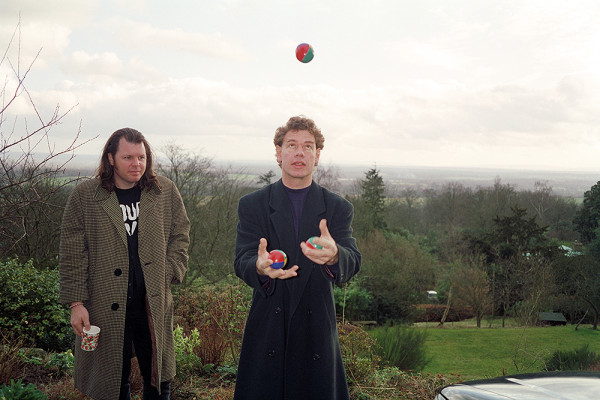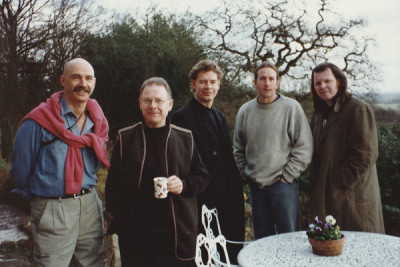In February 1994, with Adrian Belew unable to make it over to the UK, Robert Fripp, Tony Levin, Pat Mastelotto, and Trey Gunn convened at Bill Bruford’s house in Surrey to start tackling some of the new material and ideas.
Set up in the somewhat intimate confines of Bruford’s rehearsal space, they spent the next few days working through a series of motifs and themes that had been flying by Fripp’s ears for several years. Mastelotto was working behind a kit which Bill had borrowed from his neighbour, Kenney Jones of The Who. “There was a huge volume discrepancy; Bill’s on his jazz kit and I’m about three feet away from him on a big kit he used when touring with The Who, with a massive 26-inch bass drum and power toms. I covered them with towels and played them with brushes, just trying my best to get things balanced. I know I’m a loud guy but I hope I’m not always just loud. It’s about knowing where your playing sits in context. When it needs something very visceral that’s my nature but I also know when to back off. A guy reviewed a show I did when I was about 20 years old in Los Angeles. I remember he called me ‘the thinking man’s Keith Moon’,” laughs Mastelotto, who admits to being somewhat awestruck at being in the room with these players. “You can understand that it’s such a fantasy of a young Californian kid to get to play music with these kind of musicians you admire from afar. So yeah, it’s definitely fun. There’s a certain pressure too, and trying to live up to their expectations. Robert must have had an expectation of my work otherwise he wouldn’t have put me in that position, so my feeling was always that I don’t want to let him down. I went out and bought a musical dictionary because I couldn’t understand some of the things that were being talked about. For example, a coda - I didn’t know what that was. I’d heard Hey Jude a million times but nobody ever told me that that was a coda. I bought a small pocket-sized one which I could keep near me so I could pull it out of my coat pocket during rehearsals!” Mastelotto reveals that some musical terms weren’t the only thing he was unfamiliar with in those first few days. “I remember that Bill came over and called me a brick and I thought it meant that he thought I was a dumb shit or something. Then it was revealed to me that calling someone a brick was kind of a positive statement or British term of endearment; I was a brick that he could build on or that I was a support and a pal. But I didn’t know the term at that point and I immediately took it the other way! (laughs). I thought he was thinking, ‘this dumbass American that I have to share the room with!’”

Bruford smiles when recalling the slightly awkward beginnings of this partnership at his house. “I said hello to Pat and Pat said hello to me and we really started work. I’d never heard of Pat before other than from the theme song of Friends and I wouldn’t have known that at the time. I didn’t really know what to do with him nor him with me. We sat and practiced a bit and initially it was fairly fruitless and we couldn’t think what to do until the penny dropped: what you do is adopt a character, a musical identity to make this work. Pat was essentially Ringo Starr connecting with the audience and I was essentially Jamie Muir or Elvin Jones upsetting, or terrorising or floating round and causing confusion with that connection. Once you’d adopted those kinds of characters and agreed that that was a great way to go then everything else is easy and after that everything fell into place. In a way it was a reversal of Jamie Muir’s playing off of me on Larks’ Tongues In Aspic; I was the straight good boy and Muir was this creature from hell. I didn’t know what to do with him or him with me. My function was to locate a beat and play it. So, something of a reversal and I think it worked really well.”

The initial sessions played around with early sketches of One Time, Inner Garden, a Fripp piece for the two drummers called Trappist Holiday and the main themes from what would be later be called Booga Looga and THRAK received its first unveiling in a King Crimson rehearsal room. Fripp outlined his plans for the new phase of Crimsonising which detailed the intention to prepare material for a mini-album to be sold to Japanese record label Pony Canyon as a means to finance the next stage: full band rehearsals and recording at Woodstock in April and May; concerts in Buenos Aires during September and October and the recording of a full-scale album in November and December in the UK. It was going to be a busy year.
In order to facilitate all of the structures and arrangements necessary to move King Crimson from point A to point B, Fripp and his business partner, David Singleton, had created Discipline Global Mobile. The founding of DGM was both a philosophical and economic necessity, providing Fripp with an opportunity to not only establish a business run on ethical guidelines but provide a vital conduit to release music that otherwise would otherwise be deemed uncommercial. Talking to journalist Vic Garbarini in Guitar World in 1995, Fripp offered this stark insight into the differing economies of scale between the indie and the major record label. "Terrifying statistic: Robert, an artist, sold 10,000 copies of Soundscapes: Live In Argentina in less than three months with no publicity. How many records does Virgin have to sell off the rack for Robert to get exactly the same amount of money? 210,000! Scary, right?" Importantly, DGM would be able to straddle the worlds of the major and the indie sector, becoming the embodiment of the small, mobile unit he had talked about in the seventies. "The question behind creating this label was, if the relationship with Virgin fell through, could King Crimson continue? And the answer is yes," Fripp told Garbarini. Fripp served noticed of DGM's intention to do things differently, rewriting the usual small print of the copyright notice to become a manifesto in miniature. "The phonographic copyright in these performances is operated by DGM on behalf of the artists, with whom it resides. Discipline accepts no reason for artists to give away such copyright interest in their work by virtue of a ‘common practice’ which is out of tune with the time, was always questionable and is now indefensible."
Because of his commitments with Peter Gabriel, Tony Levin was only able to stay for one of the preliminary days at Bill’s house. “The hilarious thing about that session was they decided they were going to run through Red or Larks’ Tongues In Aspic, Part 2 but nobody in the room knew it as well as Pat and I,” laughs Gunn. “Of course, Pat knew the record inside and out and I had a general idea. Having been in the band what you realise is that the way they approach tracks like that is not that fixed. You have the sense ‘we do these things, and now we’re going to do them this way; now there’s a new tuning so we’ll do it this way. Even Robert couldn’t really remember how it went. It was pretty much Pat telling everyone how the form went.”
Sid Smith 2015


